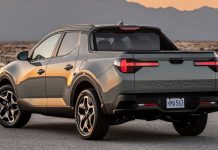Never buy a car on looks alone.
A sexy shell may hide a rough ride – or seats that make your back ache after 15 minutes of driving.
Just as you’d (hopefully) take a wider view about the person you might want to marry, take the time to consider the whole package before deciding whether to buy that four-wheeled-honey. If not, the morning after could be a rude awakening!
Here are a few things to put on your pre-buy checklist:
* Seating position/comfort:
Don’t buy a vehicle before you’ve spent some time behind the wheel – and in the seat. Chairs that seem comfortable and supportive in the showroom may feel like oak boards after a couple of hours. Or they may be too soft – another problem. Either way, the key is to find out what they’re like in real life, day-in, day-out. And the only way to do that is to insist on a test drive. A real one, not just a 10 minute toodle around the block. Most dealers will accommodate this reasonable request provided you’re a serious buyer. If not, walk away. It is better to continue shopping than to buy a car you’re not sure fits you – from a dealer who has made it pretty clear he isn’t concerned about your comfort.
* Ride quality:
Like the seats, it’s hard to know whether a given car’s ride quality is too soft, too firm, or just right without a test drive that lasts at least an hour – and takes place on a wide variety of roads, including not-so-great roads with potholes and uneven pavement.
If you haven’t gone new car shopping recently, one thing you’ll discover is that “sporty” (read: firmer – often unpleasantly so) ride quality is now the trendy thing. Aggressive, performance-type tires (short, stiff sidewalls and tread patterns designed to provide maximum grip and response to steering inputs) are being fitted to (ostensibly) family-minded and even luxury cars – which are now marketed as luxury-sport cars. High-speed handling maybe excellent, but the day-to-day ride quality may be harsher than you want to live with every day
Also be sure to try the vehicle out on bumpy secondary roads as well as smooth highways. You want to se how it feels going over less-than-perfect pavement. If the vehicle offers different suspension levels – a standard version and a “sport” upgrade – try both out. Never buy the sport suspension package just because the (usually larger) wheels that come with it look better than the ones fitted to the standard suspension model. Larger/wider wheels – and tires with shorter/stiffer sidewalls – will almost always give you a firmer – even harsher – ride.
* Controls:
How easy is it to change the radio station, adjust the climate control system and operate other vehicle controls? In their quest to be “different,” automakers sometimes graft over-complex, hard-to-use controls onto their cars that leave the owner with never-ending small hassles. For example, the use of scrolling menus and LCD displays to toggle through vs. a simple knob or button to adjust fan speed. Some of these interfaces can be very aggravating – even after you figure out how they work. Sometimes, simpler is better. Make sure you can work all the features of your next vehicle without having to take your eyes off the road or fumble with complicated controls. If the car stresses you out,it’s not the car for you.
* Real world gas mileage:
Don’t assume the fuel economy figures listed on the window sticker represent the actual mileage you will get. Especially if you are looking at the sticker on a hybrid vehicle.
The government tests new cars and trucks to get an “average” city/highway fuel economy figure – but the government’s test loop may not reflect the type of driving you do. If, for example, you drive faster than the testers did your actual fuel economy is likely to be significantly lower than the government’s rating. You may also frequently carry passengers – or pull a heavy load. These variables will affect fuel efficiency.
Never assume that the advertised 18-mpg rating (as an example) is what you will get. Read the fine print. Your mileage not only “may vary” – it almost certainly will vary. If you are budgeting a certain amount for gas bills each month based on the advertised fuel efficiency, you could find yourself paying more than you expected. Once again, the test drive offers salvation. Be sure the tank is full before you head out, and top it off just before you bring the vehicle back to the dealership. After your afternoon’s drive you’ll be able to figure out how much fuel the thing is likely to use given the type of driving that you – not government testers – do.
And don’t forget: Hybrids get their highest mileage in low-speed, city-type driving, the reverse of standard cars – which do best on the highway. If you do a lot of highway/distance driving, a hybrid’s real-world mileage may be very disappointing.
* Lifestyle and family:
Unless this car (or truck) is just for you, it’s wise to see how the members of your family like it – especially those who will be driving it regularly. A common mistake people sometimes make is to buy a vehicle that their wife or husband either dislikes immensely or is not comfortable driving. Maybe it’s “too big,” or “too cramped, “hard to get into” or “has terrible blind spots” – ultimately it doesn’t matter. What does matter is that someone else who needs to use the car doesn’t like the car you bought. Years of listening to complaining could be your penance.
Make certain – especially with SUVs and sporty cars, which can be awkward or uncomfortable for some people to drive – that anyone who will be using the vehicle regularly likes the thing. Or at least, that they don’t despise the thing.
Throw it in the Woods?














